At the Lab we’re about designing with people for people. That means ensuring we make spaces inclusive for our patients, visitors and staff.
On Wednesday a few of the team attended The Universal Design Symposium hosted by the Auckland Design Office, part of Auckland City Council. It was a great event with a range of speakers showcasing examples of inclusive design and providing some interesting disability sector context. Whilst 24% of New Zealanders identify themselves as having a functional disability today, that doesn’t account for those with sensory or brain impairments. It is also a snapshot in time, at some point many of us will develop complex needs as we age.
Key note speaker Valerie Fletcher, Executive Director of the Institute for Human Centered Design (USA) provided the platform for the day and put it nicely when she said that variation in ability is the norm, not the other way around. It just happens to be highlighted at the margins, for those with complex needs. When designing inclusively, it’s not about compliance with disability building codes, there should be no “us” and “them”. Among the speakers we heard from Dr Zena O’Connor, who also popped up to the hospital to speak at a Grand Round for us and has provided great feedback on some of our concepts for Wayfinding changes. Thank you Zena!
The day also included a tour of different Auckland city locations where good design is taking place. Some of the team can be seen below on the shared spaces tour.
Little things can make a big difference to our environment, whether it is insufficient colour contrast to differentiate furnishings or reflective surfaces that may be seen as a pool of water to visually or cognitively impaired visitors to the hospital. You can see some small examples of the DHWLabs work with inclusivity in mind here. The Auckland Design Office has a universal design toolkit coming before the end of the year that will add to their Auckland Design Manual. We’re hoping to share our Healing Environments insights that have contributed to designs in our pending Carpark A entry refurbishment.
















